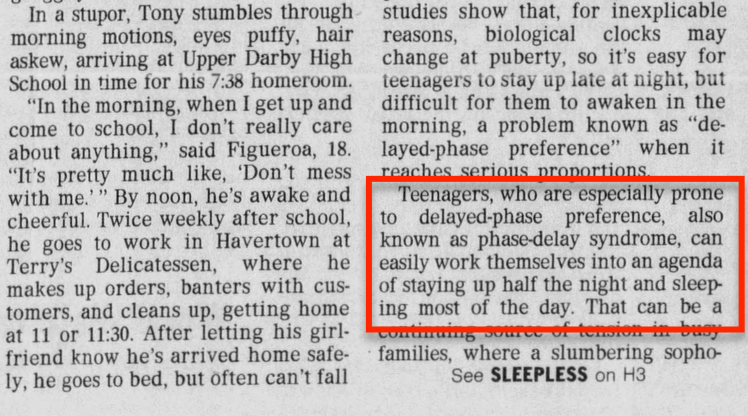Some students believe that you only need to credit a source if you use its exact words, but this is not true. Any fact that is not common knowledge (like "George Washington was the first President of the United States") needs a reference to the source. Here is an excerpt from a newspaper article by Shelly Phillips on teenagers and sleep from the newspaper called the Philadelphia Inquirer:

And here is the statement from a student paper of one of the ideas from the article. Note that the student has paraphrased the section of the article marked in red.
Today's teenagers can easily have their biological clocks thrown out of alignment. This occurs because the changes of puberty make it easy for teenagers to stay up late at night, but hard for them to get up in the morning.But that's still not enough! Even though these are not the exact words of the source, it is never acceptable to write without adding a reference to the source of the ideas that are paraphrased.
The right way to refer to this information would be as follows:
Today's teenagers can easily have their biological clocks thrown out of alignment. This occurs because the changes of puberty make it easy for teenagers to stay up late at night, but hard for them to get up in the morning (Phillips H1).
The parenthetical reference gives the last name of the author (Phillips) and the page number (section H, page 1) of the article. You would also need a corresponding entry in a "Works Cited" section at the end of the paper:
Phillips, Shelly. "Sleepless in School," Philadelphia Inquirer February 1, 1995, H1, H3.
Use the checklist given in the box below to guide you in the correct use of sources. When in doubt, consult a style manual or grammar handbook.
In writing a research paper or and other paper that uses information from one or more sources:
This page presents only the rudiments of the correct MLA format for citing journal articles. For more information on MLA format, try this link.
This page is at: http://thury.org/plagiarism.html